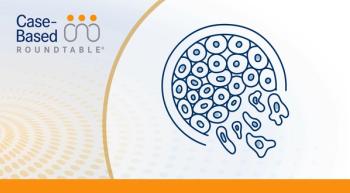
Risk Assessment of Multiple Myeloma
Ajai Chari, MD:Here we have a 74-year-old woman who presents with a severe infection, pneumococcal pneumonia, and ends up in the ICU and has classic features of multiple myeloma. She’s hypercalcemic, she has significant anemia, and she has lytic lesions on imaging picked up on the MRI. And also, we have serologic evidence with both the paraproteins by Mspike and light chains and confirmed by bone marrow involvement with 70% plasma cellsso, typical presentation of myeloma in a 74-year-old woman, with also the feature of translocation 4;14 making her more than a low-risk patient.
The risk of multiple myeloma has really evolved over time. We used to use the old Durie-Salmon staging system. One of the biggest limitations of that is that the number of lytic lesions is really very subjective based on how a radiologist might review the imaging. So, the more recent staging is really the International Staging System (ISS), which is based on beta-2 microglobulin and albumin. And so, that stratified patients into stages 1, 2, and 3 with an approximate overall survival of 3, 4, and 5 years, respectively, for 5 years for the low-risk stage 1.
The limitation of the ISS is that it didn’t include molecular information, so the revised ISS includes the ISS, the LDH, and also the molecular findings, and so certain molecular findings are very high risk in many diseases like deletion 17p. She happens to have translocation 4;14, which we consider to now be intermediate risk for multiple myeloma. So, by a revised ISS stage, we would need to look at all of those features to determine her risk status.
Transcript edited for clarity.
- A 74-year-old woman was admitted to the ICU with pneumococcal bacteremia. She complained of recent severe fatigue, loss of appetite, nausea
- History: chronic HTN, aortic insufficiency, diabetes mellitus
- X-ray of the pelvis showed numerous lytic lesions in the ilium and a large lesion in the right proximal femur
- MRI confirmed a 9-mm lesion in the right femoral head and numerous bilateral T1 hypointense and T2 hyperintense lesions in both iliac region
- Laboratory results:
- Hb, 8.3 g/dL
- Ca2+16.35 mg/dL
- Creatinine, 1.0 mg/dL
- Creatinine clearance, 59 mL/min
- M-protein, 1.6 g/dL
- B2M, 4.9 mcg/mL
- SFLC, kappa, 150 mg/L
- Bone marrow biopsy, 70% plasma cells
- Molecular testing, t(4;14)
- ECOG 2







































